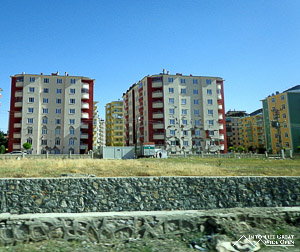Van, Turkey
On the Eastern Frontier
July 3, 2012
Yesterday and days before
Sun is cold and rain is hard
I know, been that way for all my time
And forever, on it goes
Through the circle, fast and slow
I know, it can't stop, I wonder
- Creedence Clearwater Revival

I was curious to see what Van would look like after reading about the devastating 7.2 magnitude earthquake that happened in October 2011. Pulling into the city at first glance it almost looked like nothing had happened. Sure there was a lot of construction but there is similar activity almost everywhere in Turkey because the economy is booming. On closer inspection the city is littered with large apartment buildings lying vacant with huge cracks in the walls, too structurally unsound to be inhabited. Now that it is summer the demolition work is in full swing with heavy machinery knocking down buildings and separating the remains. For me as a tourist this had rather limited effects but the most pronounced is that many things that are listed in the guide book have either ceased to exist or are in entirely different locations. This probably wouldn’t be that big of a deal if I spoke Turkish, but I don’t so it complicates things a bit. The first hotel I tried to find wasn’t there, not only was it not there but there was no building there at all, just a hole in the ground where a building used to be. The minibus stop to a nearby village was filled with a pile of rubble from a demolished building.

All these annoyances pale in comparison to what the residents must have endured during the winter. It gets cold here up on the high Anatolian plateau, like -10°C to -15°C, hardly the kind of weather you would want to endure in crumbling buildings without heat. Now that the weather has warmed, construction and rebuilding are fully under way but much work needs to be done to replace all the damaged buildings. In the meantime people live in temporary trailer parks with row upon row of identical trailers enclosed by barbed wire fences.
Living within these barbed wire fences must not feel so unfamiliar in some ways to many of the people. This area, the southeastern part of Turkey is a heavily Kurdish region and the Kurds have had a long string of conflict with the Turkish government. Today, while they have gained significant freedoms, there is still a very heavy military presence here in southeastern Turkey. The police patrol the streets conducting random ID checks, roadblocks are common between the cities, and it isn’t unusual to see six wheel armored vehicles driving down the city streets with the swiveling gun turret manned by a helmeted soldier.

The ambience of the city streets couldn’t be more opposite to the military presence and authoritative overtones. Here men walk arm in arm down the streets and sit for ages drinking tea on the sidewalks. Women aren’t as common a sight but can be seen in headscarves, chadors, jeans, and high heels. People wait patiently in absurdly long lines for ATMs and for the banks to open in the mornings. Being on the far eastern end of Turkey, for some reason I had some other vision of this city, not one of new modern shopping malls, Burger King, and store after store selling the latest smart phones.

In many ways the city and this part of Turkey reminded me so much of western China. Both feature a repressed minority, the Kurds in Turkey and the Uighurs in China. Both feature heavily guarded borders under some sort of dispute or closure, Turkey’s borders with Armenia and China’s border with India and others. Both have seen clashes between the minority and the majority. Both feature areas that are closed to foreigners, supposedly for their safety but from what I have seen I have the feeling that it is really to keep the repression hidden from public view. And sadly, all these issues in both countries are greatly overshadowed by the economic successes that their current governments are profiting from.

























































